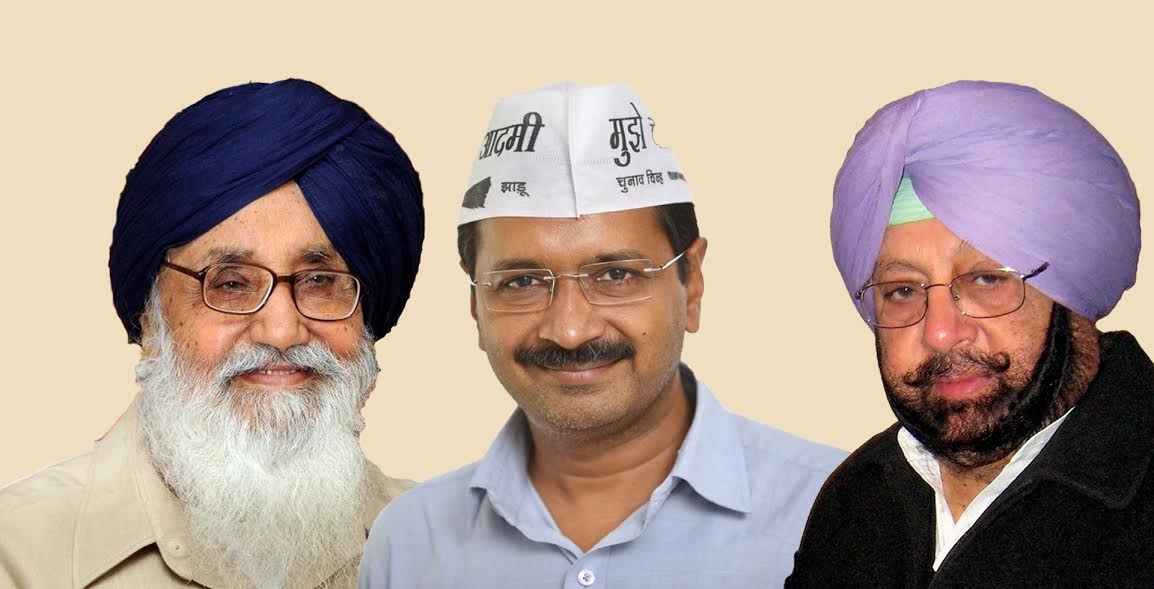With the entry of AAP, the battle of Punjab has become more fierce.
Punjab will witness another election for 117 legislative assembly seats on 4th February. Last elections held in 2012, resulted in a majority of seats being won by the ruling Shiromani Akali Dal(SAD)-BJP alliance. The Akalis secured 56 seats and BJP received 12, with Parkash Singh Badal becoming Punjab’s Chief Minister yet again.

The Current electoral situation of Punjab seems unpredictable. With the emergence of a new player (Aam Aadmi Party – AAP) in the state, we are seeing a three-sided fight. AAP, Congress and the Akali-BJP alliance are head to head. Despite demonetisation, BJP still garners support in some sections of the urban population. The SAD-BJP alliance declared Parkash Singh Badal as their joint CM candidate. There is Amarinder Singh from Congress. And Arvind Kejriwal from AAP is being projected as their candidate. Other political parties contesting for smaller number of seats include BSP, Apna Punjab Party (APP), the Left – comprising of CPI and CPI(M), and SAD-Amritsar.
AAP is a relatively new player in the Punjab electoral scene, but seems to have gained considerable mass support. The majority of Jat- Sikhs have stood historically with the Akalis. There is no reason to believe they have changed their allegiance. The Dalits and some other backward castes, which have traditionally been supporters of Congress, seem to have shifted their loyalties towards AAP.
Punjab culture and politics has witnessed the formations of Deras. Deras are rebel sects that fight against the prevailing hierarchies within Sikhism. Many of them started as reform groups. Today there are thousands on Deras in the state, including several Sikh and non-Sikh Deras. Some Deras believe in bodily forms of gurus. The gurus have an influence on the followers. But there is no reason to believe that the followers essentially vote on the instructions of the gurus.
Punjab’s political history has been an interesting one. The formation of Shiromani Akali Dal (SAD) in 1920 lead to the first concretisation of Sikh identity politics in Punjab. Akalis emergence was as a ‘safeguard’ of the Sikh religion. Though one cannot ignore the anti-colonial struggle which aided in their formation. They fought and finally gained control over the gurudwaras which were under the leadership of upper caste hindus, backed by the ruling British authorities. This legacy explains their continued support by the peasant classes. The history of Akalis is one full of splinter factions and mergers. There are several parties in the state by the name of Shiromani Akali Dal. The party recognised as SAD by the Election Commission is the one lead by Sukhbir Singh Badal. It is recognised as the real descendant of the original SAD which was presided by Sardar Sarmukh Singh Chubbal.
Historically, Congress and Akalis have ruled Punjab. Post-independence, from 1947 to 1966, Congress dominated the political scene of the state. The Punjab reorganisation Act, 1966, was the culmination of the objective of the Punjabi Suba movement. The aftermath of the reorganisation was that the Chief ministers of the state began to be Sikhs, with Gurnam Singh becoming the first CM of the new divided Punjab in 1967.
Punjab’s history is not complete unless we bring in the story of its drug trade. Leaders from Akalis, Congress and BJP have all been in the past caught for their connection with the drug trade. The officials are either scared to talk about the political connections or else have hinted obliquely to the politics-drug traders’ nexus.
Punjab faces a mass drug addiction problem which was also shown in the movie ‘Udta Punjab’. The movie showed the politicians involved in the drug trade, which caused a lot of controversy. Prof. Chamanlal, retired professor from JNU, observed that the actual problem in Punjab this time is the increase in the number of peasant suicides and the drug problem induced and aided by huge unemployment. Yet no political party is ready to talk about these two problems. He also observed that while AAP has definitely increased its mass base, but the party’s internal contradictions might put a damper on its chances of winning.
AAP while talking about the drug problem, is not focussing on larger socio-economic problem. Apart from the left, no other political party is really talking about the socio-economic problems of the state.
In the recent past, people have been agitated with the Akalis also because of their involvement in lawlessness and criminal activities. The anti-incumbency factor will also have its role to play.
Emergence of AAP as an alternate to the Congress – SAD see-saw, seems to have given some ray of hope to the people, of the possibility of a third alternative. At the moment, no one can really predict the result of this three-way fight; the final electoral victory is ultimately anyone’s game.
Courtesy: Newsclick.in